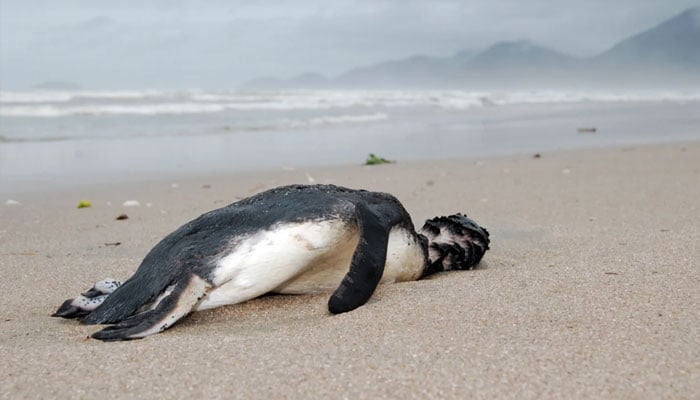Scientists investigate thousands of dead Antarctic penguins for bird flu
That’s what researchers are seeking to find out after a scientific expedition last month found at least 532 dead Adelie penguins
PARIS: Has bird flu already killed hundreds, if not thousands of penguins in Antarctica?
That’s what researchers are seeking to find out after a scientific expedition last month found at least 532 dead Adelie penguins, with thousands more thought to have died, according to a statement from Federation University Australia. While the researchers suspect the deadly H5N1 bird flu virus killed the penguins, the field tests were inconclusive, the university said. Samples are being shipped off to labs that the researchers hope will provide answers in coming months.
Scientists are concerned specifically that the often fatal H5N1 influenza could decimate threatened species of penguins and other animals on the remote southern continent. The disease has spread more aggressively in wildlife than ever before since arriving in South America in 2022 and rapidly made its way to Antarctica, where the first case of H5N1 was confirmed in February.
“This has the potential to have a massive impact on wildlife that is already being impacted by things like climate change and other environmental stresses,” said Meagan Dewar, a wildlife biologist with Federation University, who participated in the latest expedition.
Dewar told Reuters that the dead Adelie penguins were found frozen solid in the sub-zero temperatures and covered in snow on Heroina Island.
Dewar and the small team of researchers were not able to tally all of the carcasses on the large island, estimating that several thousand died in total at some time in the proceeding weeks or months.
A colony of roughly 280,000 Adelies breed on Heroina Island each year. Having finished breeding, the live penguins had already moved on by the time the expedition arrived, Dewar said.
Dewar’s expedition did find the presence of H5 strain bird flu on the Antarctic peninsula and three nearby islands in skua seabirds, predators which feed on penguin eggs and chicks.
-
 Blake Lively Claimed Justin Baldoni 'made A Monster' Of Her, Court Docs Reveal
Blake Lively Claimed Justin Baldoni 'made A Monster' Of Her, Court Docs Reveal -
 Prince William Accused Of 'harsh Decisions' Over Disgraced Royal
Prince William Accused Of 'harsh Decisions' Over Disgraced Royal -
 Dolly Parton Gets Major Surprise On 80th Birthday
Dolly Parton Gets Major Surprise On 80th Birthday -
 Jennifer Lawrence Revisits Viral Kourtney Kardashian Comment: 'Insane'
Jennifer Lawrence Revisits Viral Kourtney Kardashian Comment: 'Insane' -
 Prince William, Kate Middleton Engage In Fierce Curling Match In Scotland
Prince William, Kate Middleton Engage In Fierce Curling Match In Scotland -
 Charlie Puth Admits He Was 'very Cringe' During Early Fame
Charlie Puth Admits He Was 'very Cringe' During Early Fame -
 Prince William’s ‘failed’ Mother Diana Sparks Another Row With Prince Harry: ‘It’s Crossing A Line’
Prince William’s ‘failed’ Mother Diana Sparks Another Row With Prince Harry: ‘It’s Crossing A Line’ -
 Jennifer Garner Reflects On Special Bond With Mark Ruffalo
Jennifer Garner Reflects On Special Bond With Mark Ruffalo -
 King Charles Stuck With Supporting Prince Harry 'great Cause'
King Charles Stuck With Supporting Prince Harry 'great Cause' -
 Nicola Peltz Is 'the Issue' In Beckham Drama, Ex Stylist Claims
Nicola Peltz Is 'the Issue' In Beckham Drama, Ex Stylist Claims -
 Expert Speaks Out On Andrew’s Vicious Circle With Jeffrey Epstein Of Information Trading & Honey Traps
Expert Speaks Out On Andrew’s Vicious Circle With Jeffrey Epstein Of Information Trading & Honey Traps -
 Prince William, Kate Middleton Honour Scottish Culture By Weaving Tartan
Prince William, Kate Middleton Honour Scottish Culture By Weaving Tartan -
 King Charles’ Pact With Andrew Comes Out And It Ensures Beatrice & Eugenie Each One Thing
King Charles’ Pact With Andrew Comes Out And It Ensures Beatrice & Eugenie Each One Thing -
 ASAP Rocky Recalls 'embarrassing' First Meeting With Rihanna
ASAP Rocky Recalls 'embarrassing' First Meeting With Rihanna -
 Archie, Lilibet’s Chances At Meeting King Charles Get Promising Update: Here’s Why
Archie, Lilibet’s Chances At Meeting King Charles Get Promising Update: Here’s Why -
 Claire Foy Shares Rare Views On Typecasting Amid New Gig
Claire Foy Shares Rare Views On Typecasting Amid New Gig




